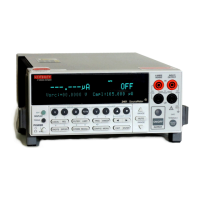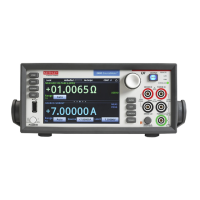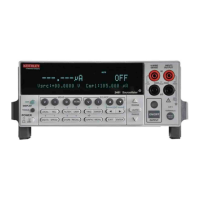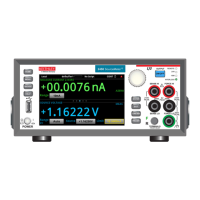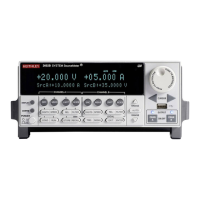2400 Series SourceMeter
®
User’s Manual Source-Measure Concepts 6-35
Inside the test fixture, a triaxial cable can be used to extend guard to the DUT. The center
conductor of the cable is used for In/Out HI, the inner shield is used for guard, and the
outer shield is used for In/Out LO and is connected to the safety shield (which is con-
nected to safety earth ground).
A coaxial cable can be used if the guard potential does not exceed 30Vrms (42.4V peak).
The center conductor is used for In/Out HI, and the outer shield is used for guard. For
higher guard potentials, use a triaxial cable as previously explained.
Figure 6-18 shows how cable guard can eliminate leakage current through the insulators in
a test fixture. In Figure 6-18A, leakage current (I
L
) flows through the insulators (R
L1
and
R
L2
) to In/Out LO, adversely affecting the low-current (or high-resistance) measurement
of the DUT.
In Figure 6-18B, the driven guard is connected to the metal guard plate for the insulators.
Since the voltage on either end of R
L1
is the same (0V drop), no current can flow through
the leakage resistance path. Thus, the SourceMeter only measures the current through the
DUT.
Cable guard should be used when sourcing or measuring low current (<1µA).
NOTE When using shielded, triaxial, or coaxial cabling with guard, the CABLE guard
setting must be used to prevent oscillations. CABLE guard is the factory default
setting.
Ohms guard
The OHMS guard selection provides a low-impedance (<1Ω), high current (up to 50mA)
driven guard. This lets you perform in-circuit ohms measurements of the DUT where other
parallel resistive paths are present. These measurements are typically performed in Delta
or Wye configurations.
NOTE Ohms guard is not available for the 1A, 3A, and 5A (2420, 2425, 2430, and
2440) ranges (source and measure). Ohms guard cannot be selected if already
on range. Conversely, if ohms guard is already selected, the 1A, 3A, and 5A
(2420, 2425, 2430, and 2440) ranges cannot be selected. See also Section 4,
“6-wire ohms measurements,” and Section 2, “Ohms guard.”
If you want to measure the resistance of a single resistor in the network, you must use the
ohms guard configuration. Figure 6-19B shows how to measure the resistance of R1. Since
the voltage on either side of R2 is the same, no current can flow through it. Thus, all the
programmed current (I
M
) from the SourceMeter will flow through R1. The voltage across
R1 is then measured, and an accurate resistance measurement is calculated, in this case
20kΩ.
NOTE Guard current (I
G
) must not exceed 50mA. If it does, the guard voltage drops
lower than the output voltage allowing leakage current. Thus, the guarded ohms
measurement becomes corrupted.
Artisan Technology Group - Quality Instrumentation ... Guaranteed | (888) 88-SOURCE | www.artisantg.com

